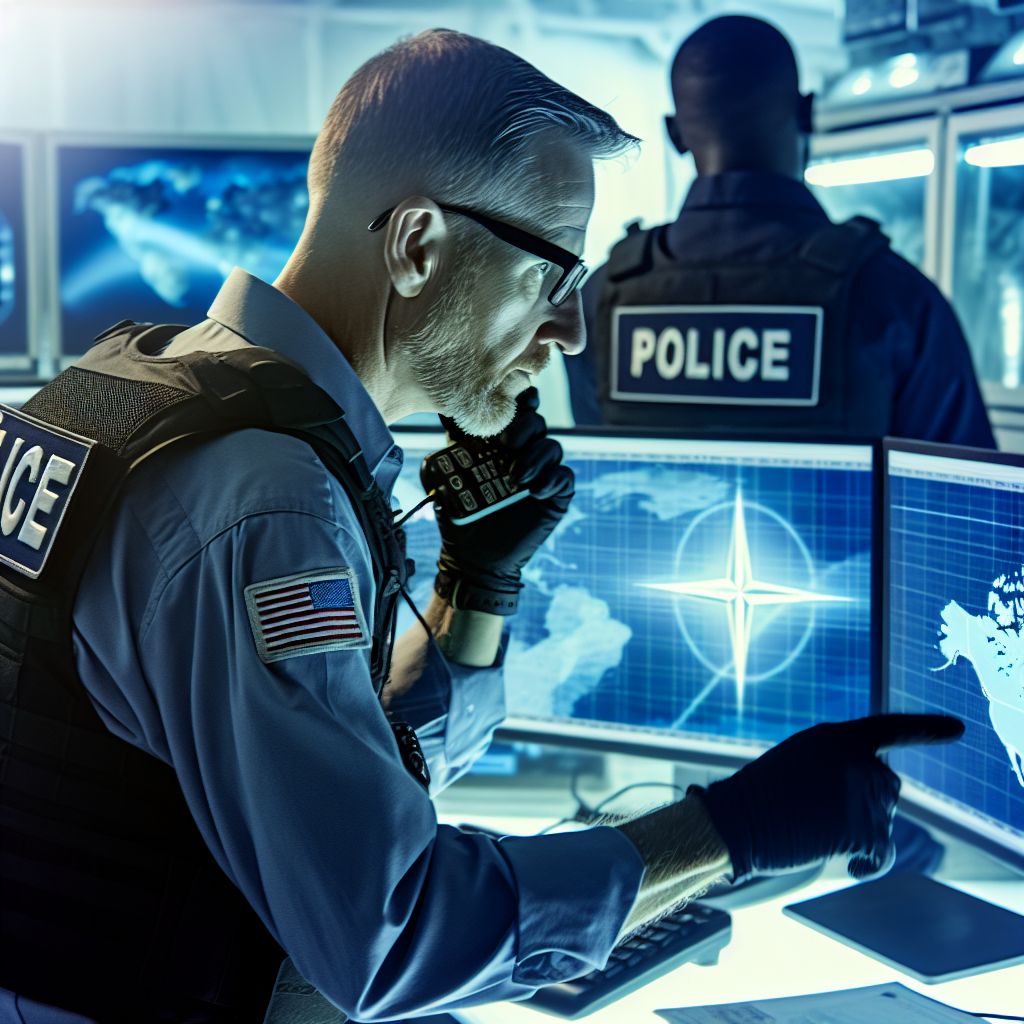Introduction:
ICE (Immigration and Customs Enforcement) plays a crucial role in enforcing immigration laws within the United States.
Technology has become an essential tool for ICE agents as they carry out their duties.
In this blog post, we will explore the various technologies used by ICE agents in their work.
Technological Innovations:
- Surveillance Systems: ICE agents utilize advanced surveillance technology to monitor and track suspected individuals.
- Biometric Identification: Biometric scanners help agents verify the identity of individuals during immigration enforcement operations.
- Data Analysis Tools: ICE employs sophisticated data analysis software to identify patterns and trends in immigration-related data.
- Drones: Unmanned aerial vehicles provide agents with aerial surveillance capabilities, enhancing their operational efficiency.
- Mobile Forensic Devices: ICE agents use mobile forensic devices to collect and analyze digital evidence during investigations.
Impact of Technology:
- Increased Efficiency: Technology enables ICE agents to streamline their operations and carry out tasks more effectively.
- Enhanced Data Collection: Advanced tools help agents gather and analyze large amounts of data for decision-making.
- Improved Border Security: Technological innovations bolster border security efforts and aid in preventing illegal crossings.
Enhancing Enforcement Capabilities:
Technology has revolutionized the way ICE agents perform their duties, providing them with advanced tools to enhance their effectiveness.
By leveraging cutting-edge technology, ICE can better enforce immigration laws and ensure the safety of the nation.
Drones:
ICE agents utilize drones for surveillance missions in border areas.
Drones provide aerial views, aiding in monitoring and tracking activities.
They help in identifying potential threats and detecting illegal border crossings.
Benefits of using drones in immigration enforcement:
- Enhanced border security by covering vast areas efficiently.
- Quick response to border incidents for timely intervention.
- Cost-effective compared to traditional surveillance methods.
Criticisms and concerns surrounding the use of drones by ICE:
- Privacy issues arise due to constant aerial surveillance in border regions.
- Potential for misuse of drone capabilities for unauthorized monitoring.
- Risks of accidents or incidents involving drones during operations.
Biometric Identification Systems:
In their work, ICE agents utilize biometric technology to accurately identify individuals.
This technology relies on unique physical characteristics or traits to verify a person’s identity.
- Explanation of biometric technology used by ICE agents: Biometric identification systems capture and analyze physiological or behavioral characteristics such as fingerprints, facial recognition, iris scans, and voice patterns to confirm identity.
- Examples of biometric identification systems in use: ICE agents use various biometric tools like Integrated Automated Fingerprint Identification System (IAFIS) and Homeland Advanced Recognition Technology (HART) for identification purposes.
- Privacy concerns and ethical implications of biometric data collection: Collection of biometric data raises concerns about privacy, consent, and potential misuse of personal information. There are ethical questions surrounding the storage and sharing of biometric data.
Find Out More: Client Onboarding Process for Security Consultants
License Plate Readers:
Role of license plate readers in tracking and apprehending undocumented immigrants.
Effectiveness of license plate readers in immigration enforcement.
Legal considerations and controversies surrounding the use of license plate readers by ICE.
Role of License Plate Readers in Tracking and Apprehending Undocumented Immigrants:
License plate readers play a crucial role in the work of ICE agents.
They aid in the identification and tracking of vehicles linked to undocumented immigrants.
These readers are equipped with cameras that capture license plate numbers as vehicles pass by.
This capability allows agents to cross-reference the data with various databases.
Through this technology, ICE can monitor the movements of suspected undocumented immigrants.
This process enables agents to locate individuals more efficiently.
Transform Your Career Today
Unlock a personalized career strategy that drives real results. Get tailored advice and a roadmap designed just for you.
Start NowEffectiveness of License Plate Readers in Immigration Enforcement:
The use of license plate readers has proven to be highly effective in immigration enforcement efforts.
They provide real-time data on vehicle locations and movements.
As a result, ICE agents can quickly respond to leads.
This responsiveness allows for the apprehension of individuals who may violate immigration laws.
Consequently, this technology has significantly increased the efficiency of immigration enforcement operations.
As a result, it has led to a higher rate of apprehensions and deportations.
Legal Considerations and Controversies Surrounding the Use of License Plate Readers by ICE:
Despite their effectiveness, the use of license plate readers by ICE has raised legal and ethical concerns.
Privacy advocates argue that the widespread collection and storage of license plate data infringe on individuals’ right to privacy.
There are concerns about the potential misuse of this technology.
Such misuse could lead to tracking individuals unrelated to immigration enforcement.
This has resulted in calls for more stringent regulations and oversight.
Such measures are necessary for the use of license plate readers by law enforcement agencies, including ICE.
Delve into the Subject: Role of Cybersecurity Specialists in Remote Work Security
Social Media Monitoring:
One of the key tools used by ICE agents in their work is social media monitoring.
By keeping an eye on platforms like Facebook, Twitter, and Instagram, agents can gather valuable intelligence on potential targets.
How ICE agents use social media to gather intelligence on potential targets
ICE agents utilize various techniques to monitor social media activity.
They may create fake accounts to infiltrate closed groups where undocumented immigrants discuss their status or plans.
Agents also use advanced search tools to track keywords related to immigration enforcement.
Examples of successful cases where social media played a role in apprehending individuals
There have been numerous instances where social media monitoring has led to successful apprehensions.
In one case, ICE agents discovered a suspect’s location by analyzing geo-tagged photos on Instagram.
Transform Your Career Today
Unlock a personalized career strategy that drives real results. Get tailored advice and a roadmap designed just for you.
Start NowThis information helped them arrest the individual for immigration violations.
Privacy issues and challenges associated with monitoring social media for immigration enforcement purposes
While social media monitoring can be an effective tool for ICE agents, it raises serious privacy concerns.
Critics argue that monitoring individuals’ online activities without consent violates their privacy rights.
There are also concerns about potential profiling and discrimination based on social media data.
Additionally, there are challenges in verifying the accuracy of information obtained through social media.
False information or misinterpreted posts could lead to wrongful arrests or investigations, causing harm to innocent individuals.
Moreover, there is a debate about the legality of using social media data as evidence in immigration enforcement cases.
Some argue that information obtained from social media may not be admissible in court due to authenticity and privacy issues.
While social media monitoring can be a valuable tool for ICE agents in their work, it also poses significant ethical and legal challenges.
As technology continues to evolve, it is crucial for policymakers to address these issues to ensure that immigration enforcement practices are carried out ethically and responsibly.
Explore Further: Managing Stress as a Personal Protection Specialist
Electronic Monitoring Devices:
Ankle bracelets and other electronic monitoring devices are commonly used by ICE.
These devices have the capability to monitor the location and movement of individuals.
However, there are restrictions on their use, such as limited battery life and signal range.
Public perception of electronic monitoring in immigration enforcement is mixed.
Critics argue that it infringes on individuals’ privacy and restricts their freedom of movement.
Supporters believe that it is a necessary tool for ensuring compliance with immigration laws.
Explore Further: Use of Force Policies in Sheriff Departments

Data Analytics:
– Immigration enforcement involves the use of data analytics and predictive modeling.
– By analyzing large sets of data, ICE agents can identify patterns and trends.
Transform Your Career Today
Unlock a personalized career strategy that drives real results. Get tailored advice and a roadmap designed just for you.
Start Now– This helps in predicting potential targets for enforcement actions.
Benefits of utilizing data analytics:
– Data analytics can enhance the efficiency and effectiveness of immigration enforcement.
– It allows ICE agents to prioritize high-risk individuals for apprehension.
– By targeting individuals with a higher likelihood of violating immigration laws, resources are utilized more effectively.
Concerns about bias and accuracy:
– One major concern surrounding the use of data analytics is the potential for bias.
– If the data used in the analysis is biased or inaccurate, it can lead to unjust outcomes.
– There is a risk of targeting certain groups unfairly based on flawed data inputs.
– ICE agents must ensure that the data used in predictive modeling is reliable and unbiased.
– Striking the right balance between efficiency and fairness is crucial in immigration enforcement.
Body Cameras:
- Body cameras play a crucial role in enhancing transparency and accountability of ICE agents.
- They provide a visual record of interactions during immigration enforcement operations.
- Body cameras have the potential to improve trust between agents and the community.
Role of Body Cameras in Enhancing Transparency and Accountability:
Body cameras worn by ICE agents serve as a tool to document their actions and decisions while on duty.
This footage can be used to review interactions with individuals and ensure that agents are following proper procedures.
By having a visual record of their actions, agents are held accountable for their behavior and can provide evidence in case of disputes or complaints.
Impact of Body Cameras on Interactions with Individuals:
When ICE agents wear body cameras, it can have a positive impact on their interactions with individuals during enforcement operations.
Knowing that their actions are being recorded, agents are more likely to adhere to protocols and treat individuals with respect.
This can help de-escalate tense situations and prevent misconduct or abuse.
Additionally, individuals may feel more comfortable knowing that there is a record of the encounter, which can improve trust between agents and the community.
Challenges and Limitations of Implementing Body Camera Technology:
While body cameras have many benefits, there are challenges and limitations to implementing this technology within ICE.
One challenge is the cost associated with purchasing and maintaining the cameras, as well as storing and managing the footage.
Additionally, there are concerns about privacy and data security, especially when recording sensitive interactions with individuals.
There may also be resistance from agents who are not comfortable with being constantly monitored.
Transform Your Career Today
Unlock a personalized career strategy that drives real results. Get tailored advice and a roadmap designed just for you.
Start NowOverall, it is important to carefully consider these challenges and limitations when implementing body camera technology within ICE.
Technology Used by ICE Agents in Their Work
ICE agents rely on a variety of technology tools to carry out their duties effectively.
Drones
Unmanned aerial vehicles are used by ICE for surveillance and monitoring in remote areas.
Facial Recognition Software
ICE agents utilize facial recognition technology to identify individuals during raids or at border checkpoints.
License Plate Readers
These devices help ICE track vehicles of interest and gather information on suspects.
Biometric Scanners
Agents use biometric scanners to collect fingerprints, iris scans, and other identifying information.
Mobile Forensic Labs
ICE carries portable kits for digital forensics to collect evidence from electronic devices.
GPS Tracking
ICE agents use GPS technology to monitor movements and activities of individuals under investigation.
Data Analytics Software
Sophisticated software is employed to analyze trends, patterns, and connections in large datasets.
Real-Time Communication
ICE agents maintain constant communication through encrypted channels to coordinate operations.
Ethical Considerations in Technology Use
The array of technologies used by ICE agents underscores the complex nature of immigration enforcement.
Reflecting on these implications raises concerns about potential privacy violations and ethical considerations.
It is important to continue evaluating the ethical and legal ramifications of technology use in immigration enforcement.
Additional Resources
Careers | U.S. Marshals Service
The Cost of Immigration Enforcement and Border Security …
[E-Books for Sale]
The Big Book of 500 High-Paying Jobs in America: Unlock Your Earning Potential
$19.99 • 500 High-Paying Jobs • 330 pages
Explore 500 high-paying jobs in America and learn how to boost your career, earn more, and achieve success!
See All 500 High-Paying Jobs of this E-Book
1001 Professions Without a Degree: High-Paying American Jobs You Can Start Now
$19.99 • 1001 Professions Without a Degree • 174 pages
Discover 1001 high-paying jobs without a degree! Unlock career tips, skills, and success strategies for just $19.99!




